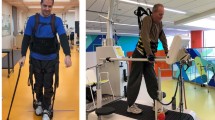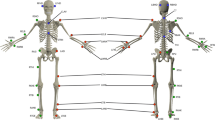Abstract
Study design:
Single-blind randomized, controlled clinical study.
Objectives:
To evaluate, using kinematic gait analysis, the results obtained from gait training on a treadmill with body weight support versus those obtained with conventional gait training and physiotherapy.
Setting:
Thirty patients with sequelae from traumatic incomplete spinal cord injuries at least 12 months earlier; patients were able to walk and were classified according to motor function as ASIA (American Spinal Injury Association) impairment scale C or D.
Methods:
Patients were divided randomly into two groups of 15 patients by the drawing of opaque envelopes: group A (weight support) and group B (conventional). After an initial assessment, both groups underwent 30 sessions of gait training. Sessions occurred twice a week, lasted for 30 min each and continued for four months. All of the patients were evaluated by a single blinded examiner using movement analysis to measure angular and linear kinematic gait parameters. Six patients (three from group A and three from group B) were excluded because they attended fewer than 85% of the training sessions.
Results:
There were no statistically significant differences in intra-group comparisons among the spatial–temporal variables in group B. In group A, the following significant differences in the studied spatial–temporal variables were observed: increases in velocity, distance, cadence, step length, swing phase and gait cycle duration, in addition to a reduction in stance phase. There were also no significant differences in intra–group comparisons among the angular variables in group B. However, group A achieved significant improvements in maximum hip extension and plantar flexion during stance.
Conclusion:
Gait training with body weight support was more effective than conventional physiotherapy for improving the spatial–temporal and kinematic gait parameters among patients with incomplete spinal cord injuries.
Similar content being viewed by others
Log in or create a free account to read this content
Gain free access to this article, as well as selected content from this journal and more on nature.com
or
References
Hesse S, Werner C . Connecting research to the needs of patients and clinicians. Brain Res Bull 2009; 78: 26–34.
Wyndaele M, Wyndaele JJ . Incidence, prevalence and epidemiology of spinal cord injury: what learns a worldwide literature survey? Spinal Cord 2006; 44: 523–529.
Ackery A, Tator C, Krassioukov A . A global perspective on spinal cord injury epidemiology. J Neurotrauma 2004; 21: 1355–1370.
Maynard Jr FM, Bracken MB, Creasey G, Ditunno Jr JF, Donovan WH, Ducker TB et al. International Standards for Neurological and Functional Classification of Spinal Cord Injury. American Spinal Injury Association. Spinal Cord 1997; 35: 266–274.
Marsolais EB, Kobetic R . Implantation techniques and experience with percutaneous intramuscular electrodes in the lower extremities. J Rehabil Res Dev 1986; 23: 1–8.
Barbeau H, Rossignol S . Recovery of locomotion after chronic spinalization in the adult cat. Brain Res 1987; 412: 84–95.
Wernig A, Müller S . Laufband locomotion with body weight support improved walking in persons with severe spinal cord injuries. Paraplegia 1992; 30: 229–238.
Dietz V, Colombo G, Jensen L . Locomotor activity in spinal man. Lancet 1994; 344: 1260–1263.
Ditunno J, Scivoletto G . Clinical relevance of gait research applied to clinical trials in spinal cord injury. Brain Res Bull 2009; 78: 35–42.
Postans NJ, Hasler JP, Granat MH, Maxwell DJ . Functional electric stimulation to augment partial weight-bearing supported treadmill training for patients with acute incomplete spinal cord injury: a pilot study. Arch Phys Med Rehabil 2004; 85: 604–610.
Field-Fote EC, Tepavac D . Improved intralimb coordination in people with incomplete spinal cord injury following training with body weight support and electrical stimulation. Phys Ther 2002; 82: 707–715.
Dobkin B, Apple D, Barbeau H, Basso M, Behrman A, Deforge D et al. Spinal Cord Injury Locomotor Trial Group. Weight-supported treadmill vs over-ground training for walking after acute incomplete SCI. Neurology 2006; 66: 484–493.
Hornby TG, Zemon DH, Campbell D . Robotic-assisted, body-weight-supported treadmill training in individuals following motor incomplete spinal cord injury. Phys Ther 2005; 85: 52–66.
Lucareli PR, Lima MO, Lima FP, Garbelotti Jr SA, Gimenes RO, Almeida JG et al. Gait analysis and quality of life evaluation after gait training in patients with spinal cord injury. Rev Neurol 2008; 46: 406–410.
Mehrholz J, Kugler J, Pohl M . Locomotor training for walking after spinal cord injury. Spine (Phila Pa 1976) 2008; 33: E768–E777.
Grillner S . Neurobiological bases of rhythmic motor acts in vertebrates. Science 1985; 228: 143–149.
Pearson KG, Rossignol S . Fictive motor patterns in chronic spinal cats. J Neurophysiol 1991; 66: 1874–1887.
Harkema SJ, Hurley SL, Patel UK, Requejo PS, Dobkin BH, Edgerton VR . Human lumbosacral spinal cord interprets loading during stepping. J Neurophysiol 1997; 77: 797–811.
Gage JR, Koop SE, Schwartz MH, Novacheck TF . The Identification and Treatment of Gait Problems in Cerebral Palsy, Series: Clinics in Developmental Medicine, no. 180–181. Mac Keith Press: London, 2009, p 644.
Perry J, Burnfield JM . Gait Analysis: Normal and Pathological Function. SLACK Incorporated: Thorofare, NJ, 2010, p 551.
Lucareli PR, D’Andrea Greve JM . Knee joint dysfunctions that influence gait in cerebrovascular injury. Clinics 2008; 63: 443–450.
Kirtley C . Clinical Gait Analysis—Theory and Practice (Hardcover). Churchill Livingstone: Oxford, 2006, p 328.
Author information
Authors and Affiliations
Corresponding author
Ethics declarations
Competing interests
The authors declare no conflict of interest.
Rights and permissions
About this article
Cite this article
Lucareli, P., Lima, M., Lima, F. et al. Gait analysis following treadmill training with body weight support versus conventional physical therapy: a prospective randomized controlled single blind study. Spinal Cord 49, 1001–1007 (2011). https://doi.org/10.1038/sc.2011.37
Received:
Revised:
Accepted:
Published:
Issue date:
DOI: https://doi.org/10.1038/sc.2011.37
Keywords
This article is cited by
-
The efficacy of gait rehabilitations for the treatment of incomplete spinal cord injury: a systematic review and network meta-analysis
Journal of Orthopaedic Surgery and Research (2023)
-
Walking after Spinal Cord Injury: Current Clinical Approaches and Future Directions
Current Physical Medicine and Rehabilitation Reports (2020)
-
Functional magnetic resonance imaging (fMRI) of the sensorimotor cortex in spinal cord injury patient after intensive rehabilitation
Research on Biomedical Engineering (2020)
-
Acute Intermittent Hypoxia as a Potential Adjuvant to Improve Walking Following Spinal Cord Injury: Evidence, Challenges, and Future Directions
Current Physical Medicine and Rehabilitation Reports (2020)
-
Influence of percentage of body-weight support on gait in patients with traumatic incomplete spinal cord injury
The Egyptian Journal of Neurology, Psychiatry and Neurosurgery (2019)



